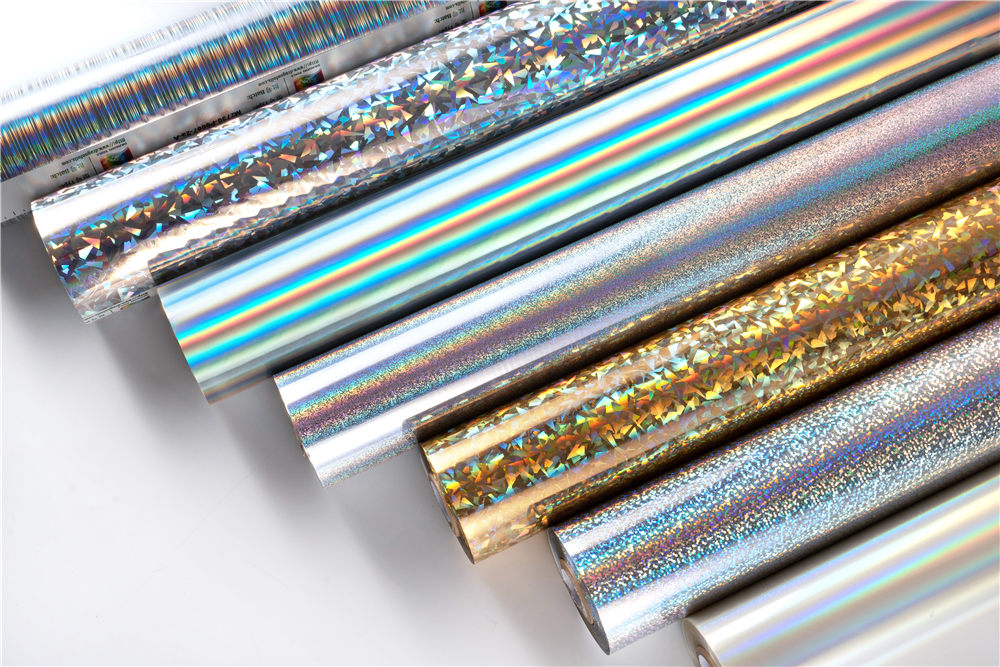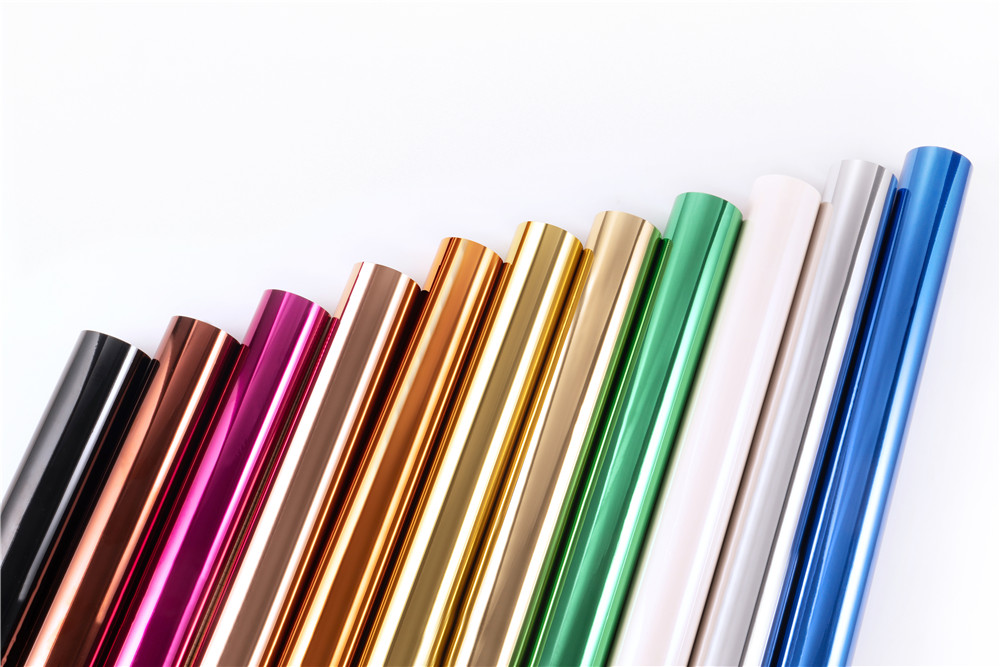Holographic Foil vs. Traditional Metallic Foil
When it comes to enhancing the visual appeal of printed materials, foil embellishments are a popular choice. Foil adds a touch of elegance and sophistication to everything from packaging to business cards. In the realm of foil, two options stand out: holographic foil and traditional metallic foil.
Unlike traditional metallic foil, holographic foil reflects light in various directions, creating a mesmerizing visual effect. The visual depth adds a dynamic quality to your designs, making them pop and catch the viewer's eye from different angles.
One of the key features that set holographic foil apart is its ability to change colors as it catches and reflects light. The color-shifting effect is created by a micro-embossed pattern that diffracts light waves. As a result, your design can appear to shift from one color to another, adding a touch of magic and mystique.
Holographic foil is known for its vibrancy and boldness. Its unique optical properties make the colors appear more intense and vivid, ensuring that your designs stand out and leave a lasting impression. This foil is perfect for projects that demand attention, such as product packaging and promotional materials.
With holographic foil, your creative possibilities are nearly limitless. Its versatility allows you to create intricate and eye-catching designs, making it a favorite among graphic designers. Whether you're designing a luxury brand's logo or crafting unique invitations, holographic foil opens up a world of creative options.

Traditional metallic foil has an enduring charm rooted in its classic, shimmering appearance. It provides a timeless elegance that has been appreciated in the world of design for generations.
Unlike holographic foil, traditional metallic foil offers a consistent and single-color appearance. They can be advantageous in projects where a uniform look is preferred. Whether it's gold, silver, or any other metallic shade, you can rely on traditional metallic foil to maintain color consistency.
Traditional metallic foil's subtle shimmer adds an element of refinement and class to any design. It's perfect for projects that demand a touch of understated elegance, such as wedding invitations, business cards, and high-end product packaging.
Working with traditional metallic foil is straightforward, making it a practical choice for designers and printers. It adheres well to a variety of paper stocks and is easy to cut and shape. The ease of integration ensures a smooth production process, making it a reliable choice for large print runs.

The choice between holographic and traditional metallic foil largely depends on the nature of your project. If you're designing a cutting-edge tech product or want to create a design that stands out with vibrant, shifting colors, holographic foil is your go-to option. On the other hand, if your project demands timeless elegance and classic appeal, traditional metallic foil will serve you well.
Your brand's identity plays a significant role in foil selection. If your brand is known for its modern and innovative approach, holographic foil can reflect those qualities. However, if your brand stands for heritage, tradition, and timelessness, traditional metallic foil will align better with your identity.
Consider your budget and the quantity of printed materials you need. Holographic foil can be more expensive than traditional metallic foil due to its intricate production process. If you're working on a limited budget or require a large print run, traditional metallic foil might be the more practical choice.
The complexity of your design is another crucial factor. If you have intricate and detailed artwork, holographic foil allows you to showcase those details with its depth and color-shifting capabilities. Conversely, traditional metallic foil is a better fit for simple and clean designs.
Both holographic and traditional metallic foil have their unique strengths when it comes to aesthetics. Ultimately, your choice should be guided by the nature of your project, your brand's identity, your budget, and the complexity of your design. By carefully considering these factors, you can ensure that your choice of foil enhances the aesthetics of your printed materials and delivers the impact you desire. Whether you opt for holographic foil or traditional metallic foil, you'll be adding a touch of brilliance to your designs.
Holographic Foil: A Dazzling Spectacle
Unmatched Visual Depth
Unlike traditional metallic foil, holographic foil reflects light in various directions, creating a mesmerizing visual effect. The visual depth adds a dynamic quality to your designs, making them pop and catch the viewer's eye from different angles.
Shifting Colors
One of the key features that set holographic foil apart is its ability to change colors as it catches and reflects light. The color-shifting effect is created by a micro-embossed pattern that diffracts light waves. As a result, your design can appear to shift from one color to another, adding a touch of magic and mystique.
Vibrant and Striking
Holographic foil is known for its vibrancy and boldness. Its unique optical properties make the colors appear more intense and vivid, ensuring that your designs stand out and leave a lasting impression. This foil is perfect for projects that demand attention, such as product packaging and promotional materials.
Endless Design Possibilities
With holographic foil, your creative possibilities are nearly limitless. Its versatility allows you to create intricate and eye-catching designs, making it a favorite among graphic designers. Whether you're designing a luxury brand's logo or crafting unique invitations, holographic foil opens up a world of creative options.

Traditional Metallic Foil: Timeless Elegance
Classic Shine
Traditional metallic foil has an enduring charm rooted in its classic, shimmering appearance. It provides a timeless elegance that has been appreciated in the world of design for generations.
Consistent Color
Unlike holographic foil, traditional metallic foil offers a consistent and single-color appearance. They can be advantageous in projects where a uniform look is preferred. Whether it's gold, silver, or any other metallic shade, you can rely on traditional metallic foil to maintain color consistency.
Subtle Refinement
Traditional metallic foil's subtle shimmer adds an element of refinement and class to any design. It's perfect for projects that demand a touch of understated elegance, such as wedding invitations, business cards, and high-end product packaging.
Easy Integration
Working with traditional metallic foil is straightforward, making it a practical choice for designers and printers. It adheres well to a variety of paper stocks and is easy to cut and shape. The ease of integration ensures a smooth production process, making it a reliable choice for large print runs.

Choosing the Right Foil for Your Project
Consider the Nature of Your Project
The choice between holographic and traditional metallic foil largely depends on the nature of your project. If you're designing a cutting-edge tech product or want to create a design that stands out with vibrant, shifting colors, holographic foil is your go-to option. On the other hand, if your project demands timeless elegance and classic appeal, traditional metallic foil will serve you well.
Think About Your Brand's Identity
Your brand's identity plays a significant role in foil selection. If your brand is known for its modern and innovative approach, holographic foil can reflect those qualities. However, if your brand stands for heritage, tradition, and timelessness, traditional metallic foil will align better with your identity.
Budget and Quantity
Consider your budget and the quantity of printed materials you need. Holographic foil can be more expensive than traditional metallic foil due to its intricate production process. If you're working on a limited budget or require a large print run, traditional metallic foil might be the more practical choice.
Design Complexity
The complexity of your design is another crucial factor. If you have intricate and detailed artwork, holographic foil allows you to showcase those details with its depth and color-shifting capabilities. Conversely, traditional metallic foil is a better fit for simple and clean designs.
Conclusion
Both holographic and traditional metallic foil have their unique strengths when it comes to aesthetics. Ultimately, your choice should be guided by the nature of your project, your brand's identity, your budget, and the complexity of your design. By carefully considering these factors, you can ensure that your choice of foil enhances the aesthetics of your printed materials and delivers the impact you desire. Whether you opt for holographic foil or traditional metallic foil, you'll be adding a touch of brilliance to your designs.
